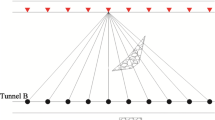Abstract
Sequential imaging of the temporal changes inP-wave velocity offers a practical tool to monitor a rock mass. Using established correlations between the location of seismic events and velocity structure, the temporal seismic potential characteristics of the rock may be monitored. Furthermore, the temporal velocity differences isolate the time dependent factors effecting velocity such as stress, while cancelling static factors such as lithology. Various sequential imaging techniques were compared with respect to accuracy. Differences between successive velocity images were found to have relatively high associated error estimates. However, images of velocity differences calculated from measured travel time delays between successive velocity surveys were found to have lower error estimates. In particular, travel time delays measured using cross-correlation techniques resulted in the most accurate sequential image. Two 3D sequential imaging studies were carried out at Strathcona Mine in Sudbury, Ontario, Canada. Results of the average static images indicated an association between the location of induced microseismicity and a zone of both high velocity and high gradient. Additional examples are described from the global seismology literature which also show a similar correlation between seismicity and velocity structure. We attribute this association to an interrelated stress and strength effect. The Strathcona Mine sequential images show zones of significantly decreased velocity in regions of concentrated microseismic activity, which are postulated to be indications of localized destressing and relaxation of the clamping forces resulting in the microseismicity. The zones of decreased velocity corresponded to an increase in the velocity gradient. One of the case studies also shows an increase in velocity in a zone of high static velocity, which is later the site of am N 2.5 mining-induced seismic tremor. The increase in velocity is believed to correspond to a region of stress concentration, resulting in the subsequent seismic tremor.
Similar content being viewed by others
References
Amato, A., Alessandrini, B., Cimini, G. B., andSelvaggi, G. (1991),Three-dimensional P-velocity Structure and Seismicity in the Upper Mantle of Italy, EOS Trans. AGU72, 349.
Birch, F. (1960),The Velocity of Compressional Waves in Rocks to 10 Kilobars, Part 1, J. Geophys. Res.65, 1083–1102.
Falls, S., Young, R. P., Carlson, S., andChow, T. (1992),Ultrasonic Tomography and Acoustic Emission in Hydraulically Fractured Lac du Bonnet Grey Granite, J. Geophys. Res.97, 6867–6884.
Ishida, M., andHasemi, A. K. (1988),Three-dimensional Fine Velocity Structure and Hypocentral Distributions of Earthquakes Beneath the Kanto-Tokai District, Japan, J. Geophys. Res.93, 2076–2094.
Jaeger, J. C., andCook, N. G. W. Fundamentals of Rock Mechanics (Methuen and Co., London, 1969).
Kormendi, A., Bodosky, T., Hermann, L., Dianiska, L., andKalman, T. (1986),Seismic Measurements for Safety in Mines, Geophysical Prospecting34, 1022–1037.
Lees, J. M. (1990),Tomographic P-wave Velocity Images of the Loma Prieta Earthquake Asperity, Geophys. Res. Lett.17, 1433–1436.
Lees, J. M., andMalin, P. E. (1990),Tomographic Images of P-wave Velocity Variation at Parkfield, California, J. Geophys. Res.95, 21793–21804.
Maxwell, S. C., andYoung, R. P. (1993),A Comparison between Active Source and Passive Source Images, Bull Seismol. Soc. Am., in press.
McGaughey, W. J. (1990),Mining Applications of Crosshole Seismic Tomography. Ph.D. Dissertation, Queen's University, Kingston, Ontario, Canada.
Michael, A. J., andEberhart-Phillips, D. (1991),Relations Among Fault Behaviour, Subsurface Geology, and Three-dimensional Velocity Models, Science253, 651–654.
Nicholson, C., andLees, J. M. (1992),Travel Time Tomography in the Northern Coachella Valley Using the Aftershocks of the 1986 M L 5.9 Paula Springs Earthquake Geophys. Res. Lett.19, 1–4.
Popandopulo, G. A. (1990),Three-dimensional Velocity Model Using Small Earthquakes Data (in Russian), Regime Geophysical Observations Acad. Sci. USSR, Moscow-Garm, 104–125.
Press, W. H., Flannery, B. P., Teukolsky, S. A., andVetterling, W. T.,Numerical Recipes: The Art of Scientific Computing (Cambridge Press, Cambridge 1986).
Ramirez, A. L., andDaily, W. D. (1987),Evaluation of Alterant Geophysical Tomography in Welded Tuff, J. Geophys. Res.92, 7843–7853.
Su, W. H., andCotten, S. A.,Verification of a seismic tomogram interpretation by finite element analysis. InRock Mechanics (Balkema, Rotterdam 1992).
Thomsen, L. (1986),Weak Elastic Anisotropy, Geophysics.51, 1954–1966.
Xu, S., King, M. S., andWorthington, M. H.,Elastic wave propagation and hydraulic properties of cracked rocks, InMechanics of Jointed and Faulted Rock (Balkema, Rotterdam 1990).
Young, R. P., Talebi, S., Hutchins, D. A., andUrbancic, T. I. (1989),Source Mechanism Studies of Mining-induced Microseismic Events at Strathcona Mine, Sudbury, Canada. Special Issue of Pure and Appl. Geophys. on Mining Induced Seismicity129, 455–474.
Young, R. P., Hutchins, D. A., McGaughey, W. J. Seismic imaging ahead of mining in rockburst prone ground. InRockburst and Seismicity in Mines (ed. Fairhurst, Charles) (Balkema, Rotterdam, 1990), pp. 231–236.
Young, R. P., andMaxwell, S. C. (1992),Seismic Characterization of a Highly Stressed Rock Mass Using Tomographic Imaging and Induced Seismicity, J. Geophys. Res.97, 12361–12373.
Zhao, D. (1990),A Tomographic Study of Seismic Velocity Structure in the Japan Islands, Ph.D. Dissertation, Tohoku University.
Zimmerman, R. W., andKing, M. S. (1985),Propagation of Acoustic Waves Through a Cracked Rock, Proc. 26th U.S. Symposium on Rock Mechanics, Rapid City, SD, 739–745.
Author information
Authors and Affiliations
Rights and permissions
About this article
Cite this article
Maxwell, S.C., Young, R.P. Sequential velocity imaging and microseismic monitoring of mining-induced stress change. PAGEOPH 139, 421–447 (1992). https://doi.org/10.1007/BF00879945
Received:
Revised:
Accepted:
Issue Date:
DOI: https://doi.org/10.1007/BF00879945




